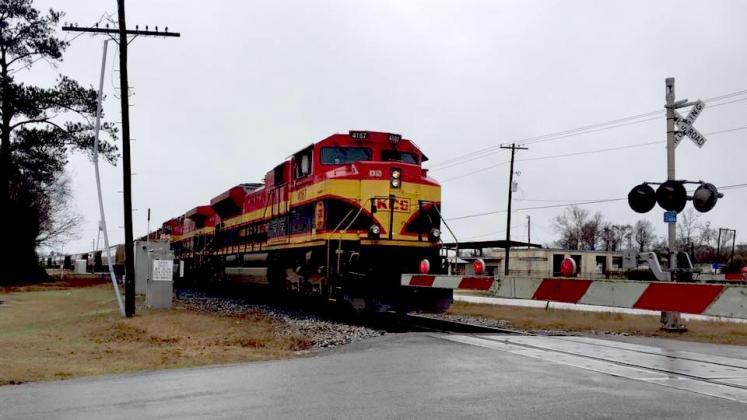WARNING: Train horn curse approaching
READ AT YOUR OWN RISK
Most people living in the southern half of Liberty County live within hearing distance of a railroad track. Dozens of trains roll through here every day and night, so many and so often that the majority of us have become almost oblivious to the noise.
Liberty might be the only city in the world that would think nothing of building a public library next to a railroad track.
But, if you live here, as many times as you have heard the trains going through, blowing their horns at every crossing, have you ever noticed there is a pattern to the blasts of those airhorns?
When approaching a public grade crossing the engineer is required to blow the horn four times in the patter of two long blasts, one short blast, and then a final long one.
— — • —
Liberty has 13 railroad crossings from the bypass to Tennessee Street near the river. Those 52 blows of a locomotive’s airhorn can seem like one, long and continuous noise. That is assuming you still consciously hear it. Federal law requires horns be sounded at public crossings for a minimum of 15 seconds and a maximum of 20 seconds. That adds up to 3 minutes and 15 seconds of noise for a train to get through Liberty, except that unless it’s going terribly slow a train does not spend 15 seconds between one street and the next in Liberty. It is only 2.5 miles from the bypass to Tennessee. If a train is moving at 50 mph, it covers that distance in 3 minutes. So, its airhorn does sound almost continuously the whole way.
This is where the curse comes in. Now that you know there is a pattern to the noise, you will consciously hear it, over and over and over. Tonight, and maybe every night for a long while, you will lie in bed wide awake, counting horn blasts.
BWAAAAAAAAAAAAHHHHHHHP (1), BWAAAAAAAAAAAAHHHHHHHP (2), BWAAAHHHP (3), BWAAAAAAAAAAAAHHHHHHHP (4).
That’s at the bypass, you’ll say to yourself.
BWAAAAAAAAAAAAHHHHHHHP (1), BWAAAAAAAAAAAAHHHHHHHP (2), BWAAAHHHP (3), BWAAAAAAAAAAAAHHHHHHHP (4).
Wallisville Road.
BWAAAAAAAAAAAAHHHHHHHP (1), BWAAAAAAAAAAAAHHHHHHHP (2), BWAAAHHHP (3), BWAAAAAAAAAAAAHHHHHHHP (4).
San Jacinto Street.
BWAAAAAAAAAAAAHHHHHHHP (1), BWAAAAAAAAAAAAHHHHHHHP (2), BWAAAHHHP (3), BWAAAAAAAAAAAAHHHHHHHP (4).
Fannin.
BWAAAAAAAAAAAAHHHHHHHP (1), BWAAAAAAAAAAAAHHHHHHHP (2), BWAAAHHHP (3), BWAAAAAAAAAAAAHHHHHHHP (4).
Main.
BWAAAAAAAAAAAAHHHHHHHP (1), BWAAAAAAAAAAAAHHHHHHHP (2), BWAAAHHHP (3), BWAAAAAAAAAAAAHHHHHHHP (4).
Travis.
BWAAAAAAAAAAAAHHHHHHHP (1), BWAAAAAAAAAAAAHHHHHHHP (2), BWAAAHHHP (3), BWAAAAAAAAAAAAHHHHHHHP (4).
Milam.
BWAAAAAAAAAAAAHHHHHHHP (1), BWAAAAAAAAAAAAHHHHHHHP (2), BWAAAHHHP (3), BWAAAAAAAAAAAAHHHHHHHP (4).
Austin.
BWAAAAAAAAAAAAHHHHHHHP (1), BWAAAAAAAAAAAAHHHHHHHP (2), BWAAAHHHP (3), BWAAAAAAAAAAAAHHHHHHHP (4).
Crockett.
BWAAAAAAAAAAAAHHHHHHHP (1), BWAAAAAAAAAAAAHHHHHHHP (2), BWAAAHHHP (3), BWAAAAAAAAAAAAHHHHHHHP (4).
Bowie.
BWAAAAAAAAAAAAHHHHHHHP (1), BWAAAAAAAAAAAAHHHHHHHP (2), BWAAAHHHP (3), BWAAAAAAAAAAAAHHHHHHHP (4).
Louisiana.
BWAAAAAAAAAAAAHHHHHHHP (1), BWAAAAAAAAAAAAHHHHHHHP (2), BWAAAHHHP (3), BWAAAAAAAAAAAAHHHHHHHP (4).
Alabama.
BWAAAAAAAAAAAAHHHHHHHP (1), BWAAAAAAAAAAAAHHHHHHHP (2), BWAAAHHHP (3), BWAAAAAAAAAAAAHHHHHHHP (4).
Tennessee.
There are other train horn signals you might hear on occasion — three short blasts for backing up; one long followed by three short blasts to tell a flagman to protect the rear of the train; or three short and then a long to say the same thing about the front of the train. If you travel much, you might hear one long blast when a train approaches a station platform, assuming you travel to places where there are stations with platforms.
Should the reader decide to look this up for himself in the hope of shooting me an email telling me I’m wrong about it, be sure to include “whistle” as one of the search terms. Trains do not have whistles anymore, but railroad enthusiast still like to call them that. The whistles used on steam locomotives made a prettier sound than airhorns do.
Train aficionados can tell you the names of different train whistles and the notes they played. Long before Casey Jones became famous for the crash that killed him, he was already well know in parts of the country for the train whistle he designed that was copied and used by many railroad companies.
If trains still used whistles, maybe hearing so many trains go by at night wouldn’t be so bad.
By the way, this counting horn blast curse is passed on to you courtesy of Mary Anne Campbell, who pointed it out to me.
SUBSCRIBE to the print edition of THE VINDICATOR here for as little as 77¢ a week. Or, buy only the e-Edition for as little as 68¢ a week. Subscription rates start at $17.50. THE VINDICATOR has been reporting the local news and sports in Liberty County for 132 years now, and we've just about gotten the hang of it.

